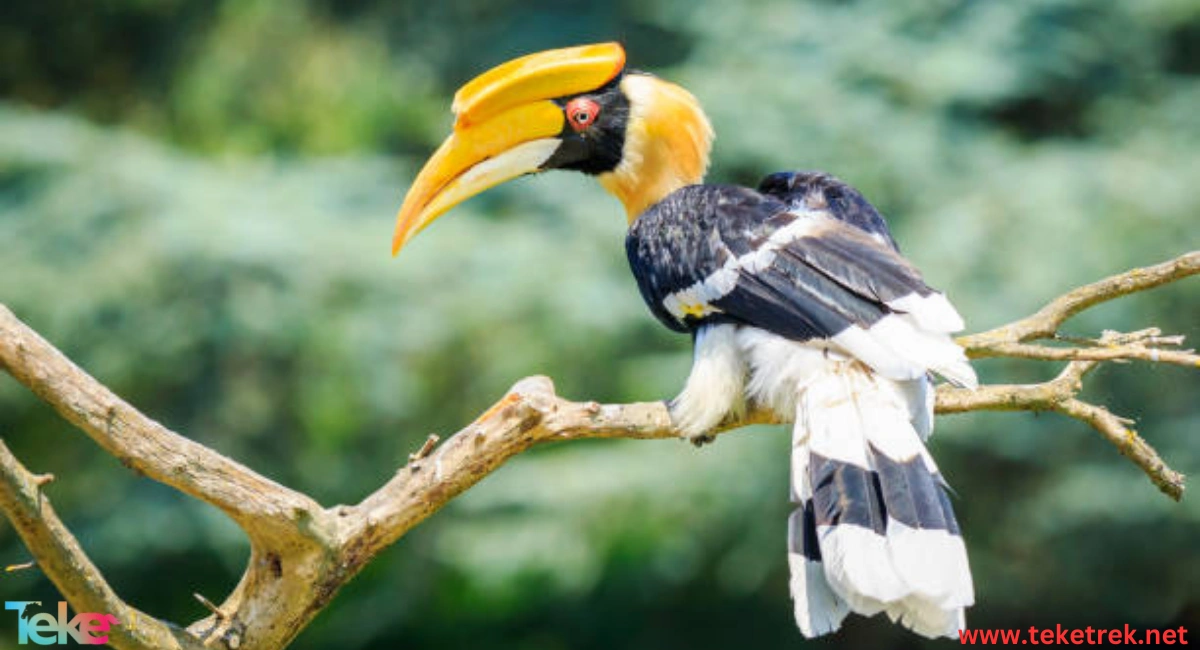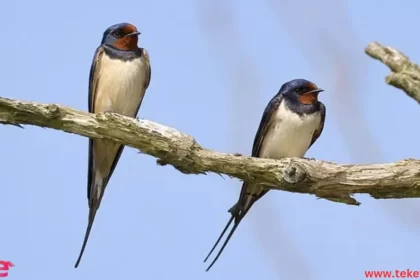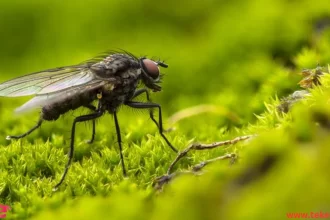is a bird found in the Bucerotidae family, belonging to the order Bucerotiformes, class Aves, and phylum Chordata.
Let’s learn more about it from teketrek.
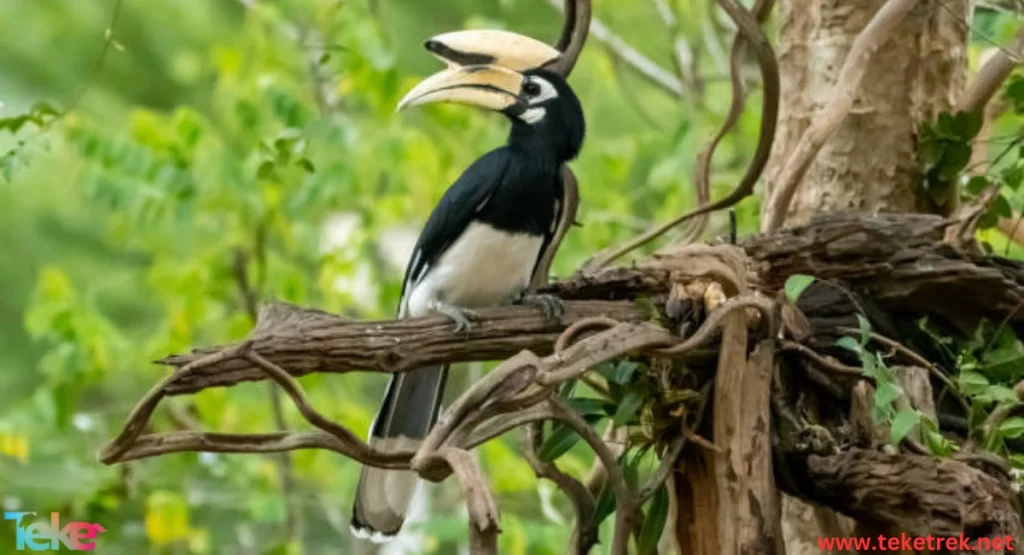
Facts about The Hornbill Bird
This bird is known as the hornbill with a helmet, and it is named after the large hornbill because it has a yellow protuberance on top of its beak resembling a horn.
This protuberance gives the hornbill bird a unique and strange appearance, distinguishing it from other birds.
Despite the large size of the hornbill bird, it is very agile in combat among its peers, and its movements are not slow.
The hornbill bird spends most of its time perched on tree branches and always looks for old trees to create cavities where the female lays her eggs.
They are living in groups of up to 8 birds with only one breeding pair, and producing loud noises that can be heard up to 100 meters away.
The protuberance on the hornbill’s beak contributes to amplifying its calls and grows as the bird matures.
The bulge on the hornbill’s head gives a pressure tone to its voice and amplifies it. This bulge continues to grow when the bird is 6 months old and reaches completion at the age of five years.
The hornbill’s personality is charming and attractive due to its colors and appearance, as well as its free-flying behavior.
The Rhinoceros hornbill nests in tree cavities, with the exception of two species, the African hornbill and the Southern hornbill. It spends its time roaming, then returns to the air.
Some species of rhinoceros birds work to improve the color of their beak by rubbing and scratching it against the fungi of the body, which makes their beak red or different.
The bump at the top of the hornbill’s beak is made of keratin, the same material as nails, hair, and horns.
The reason for the large body size of the bird is the fusion of new organs to support the large weight of the head, beak and horn.
The Hornbill Bird specifications
Beak: The beak is strong, flat, and curved from the top.
Size:large size.
Movements: movements are not slow.
Length: The hornbill bird has a length ranging from 30 cm to 120 cm.
Weigh:It weighs around 2.5 kg.
Color: It has a black body with a white belly, white tail with a broad black band near the base.
Wings: Both males and females have large wings.
Eyes: Males have red eyes while females have white eyes, also they have large eyes surrounded by immediate eyelashes.
Head, neck: The hornbill bird has a short head, and a very long neck.
Age: They can live up to 35 years.
Where do Hornbills live?
The Hornbill lives in most regions of the world.
It is a tropical bird and lives in Sub-Saharan Africa, the Philippines, the Solomon Islands, and the Pacific Islands.
The hornbill prefers to live in forests, woodlands, and open savannahs.
What does Hornbill bird eat?
The hornbill is bird carnivorous , and its favorite foods are fruits and small insects.
The beak of the hornbill bird helps in picking fruits, as it has slits at the end of the beak to assist in picking them
is a bird found in the Bucerotidae family, belonging to the order Bucerotiformes, class Aves, and phylum Chordata.
The species of hornbill birds:
1. Round-helmeted Hornbill:
This hornbill species is characterized by a large yellow beak topped with a rounded helmet-like protuberance, representing 10% of the weight of the bird.
This bird lives in rainforests at an altitude not exceeding 1500 meters above sea level.
2. Silver-cheeked Hornbill (Silver breast Broad-billed ):
This hornbill species is characterized by its bright color tending towards silver, hence its name.
It can be found in desert forests and all types of wooded forests.
3. Black-billed Hornbill (African Grey Hornbill):
The grey-cheeked hornbill has a gray face while the rest of its body is black and white.
It lives in urban and large arboreal forests.
Reproduction stages in solitary hornbill birds:
The hornbill is a monogamous partner, mating with one partner in most cases due to their unique communication differences, making courtship not an easy task.
During courtship, the male hornbill displays behaviors like communication through beak movements, calls, and chasing.
The male brings food to the female to demonstrate readiness for the relationship.
The female hornbill lays eggs over several days.
The male hornbill protects the female and offspring by covering the cavity.
The male feeds the female through a small hole while she incubates the eggs.
The female incubates the eggs for 23 to 96 days, and when the eggs hatch, their companion emerges from the covered cavity and leaves it behind.
The siblings compete for limited resources, with older siblings having a better chance at life.
Sometimes, siblings are left to die of starvation.
A solitary hornbill may take up to six years to reach full sexual maturity.
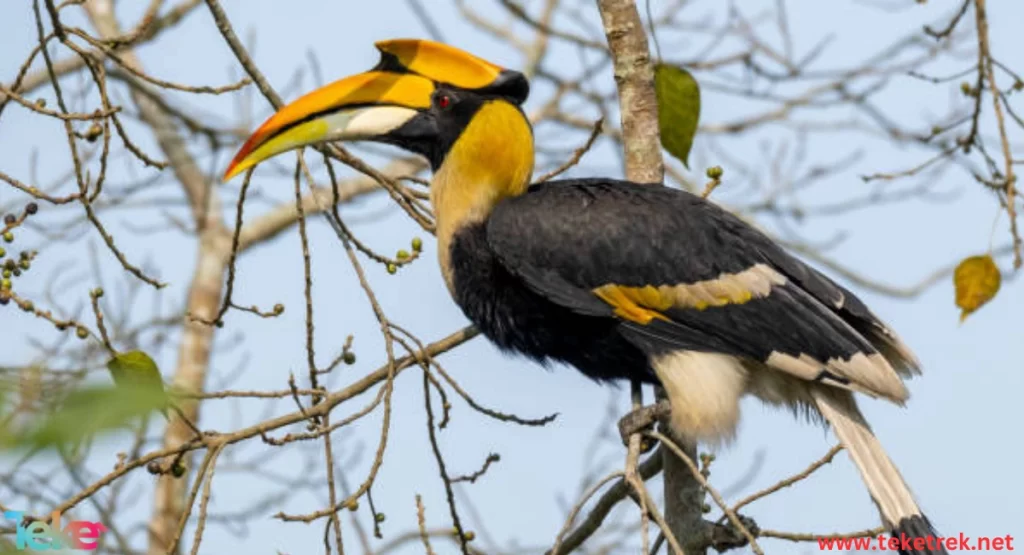
FAQs about Hornbill
To which class and family does the rhinoceros hornbill belong?
This bird is found in the Rhinoceros hornbill in the class Aves and the family Bucerotidae in the class Bucerotiformes.
What is special about hornbills?
It features a massive beak with a bright yellow and black helmet.
?How intelligent are hornbills
They are very intelligent.
?What is hornbill behavior
They are fairly social birds but do not live-in large flocks, instead forming small family groups or flocks of up to 40 individuals.
?Are hornbills aggressive
Hornbills are both mischievous and aggressive birds.
In summary, the hornbill is a symbol of beauty and elegance in the bird world, characterized by its vibrant features and beautiful plumage.
Thanks to its remarkable adaptation to various environments, the hornbill plays an important role in spreading plant species within the ecosystem.
However, it faces challenges from natural inhabitants and threats due to deforestation and climate change.
Therefore, addressing these threats requires international action to protect its natural habitat, putting us on the right path towards biodiversity conservation and environmental diversity.
References:
Wikipedia

